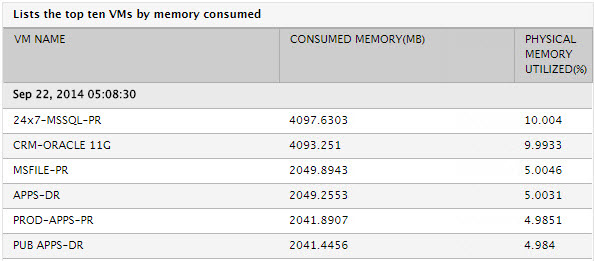OVM – Memory Test
Excessive memory usage by the Oracle VM server and its VMs can significantly degrade the quality of a user’s experiencewith the server. Under such circumstances, administrator need to identify what is causing the memory bottleneck – is it the host? Or is the VMs on the host? Using the OVM – Memory test administrators can quickly understand how the VMs are using the memeory resources and can thus determine whether/not they are likely to cause a memory contention on the host.
Target of the test : Oracle VM Server
Agent deploying the test : A remote agent
Outputs of the test : One set of results for the Oracle VM Server being monitored.
| Parameters | Description |
|---|---|
|
Test Period |
How often should the test be executed. |
|
Host |
The host for which the test is to be configured. |
|
Port |
The port at which the specified Host listens. By default, this is NULL. |
|
Oracle VM Manager, Oracle VM Manager User, Oracle VM Manager Password, and Confirm Password |
This test remotely connects to the Oracle VM Manager that manages the monitored Oracle VM Server and uses the web services API of the Oracle VM Manager to pull out metrics of interest. To enable this test to communicate with the web services API, you first need to configure the test with the IP address or host name of the Oracle VM Manager. This can be done using the Oracle VM Manager text box. Then, you need to configure the test with the credentials of a user with Admin rights to the Oracle VM Manager. Use the Oracle VM Manager User and Oracle VM Manager Password parameters to configure these credentials. Finally, confirm the password by retyping it in the Confirm Password text box. |
|
SSL |
By default, the Oracle VM Manager is SSL-enabled. Accordingly, the SSL flag is set to Yes by default. This indicates that the eG agent will communicate with the Oracle VM Manager via HTTPS by default. |
|
WebPort |
By default,, the Oracle VM Manager listens on 7002. This implies that while monitoring an Oracle VM server via an SSL-enabled Oracle VM Manager, the eG agent, by default, connects to port 7002 of the Oracle VM Manager to pull out metrics. In some environments however, this default port may not apply. In such a case, against the WebPort parameter, you can specify the exact port at which the Oracle VM Manager in your environment listens so that the eG agent communicates with that port. |
|
Detailed Diagnosis |
To make diagnosis more efficient and accurate, the eG Enterprise embeds an optional detailed diagnostic capability. With this capability, the eG agents can be configured to run detailed, more elaborate tests as and when specific problems are detected. To enable the detailed diagnosis capability of this test for a particular server, choose the On option. To disable the capability, click on the Off option. The option to selectively enable/disable the detailed diagnosis capability will be available only if the following conditions are fulfilled:
|
| Measurement | Description | Measurement Unit | Interpretation |
|---|---|---|---|
|
Total physical memory |
Indicates the total amount of physical memory on the host. |
MB |
|
|
Memory usable by VMs |
Indicates the amount of memory allocated to VMs for use. |
MB |
|
|
Used physical memory |
Indicates the amount of physical memory used. |
MB |
A low value is desired for this measure. |
|
Usage of physical memory |
Indicates the percentage of total physical memory resources used. |
Percent |
A value close to 100% is indicative of excessive usage of physical memory on the host. This can significantly degrade the performance of the host operating system. |
|
Memory consumed by VMs |
Indicates the amount of physical memory consumed by the VMs. |
MB |
Ideally, the value of this measure should be low. Using the detailed diagnosis of this measure, you can determine the amount of memory used by each VM. |
|
Percent of physical memory free |
Indicates the percentage of physical memory resources of the host that is currently unused. |
Percent |
A very low value for this measure indicates a shortage of memory resources. If more machine memory is not made available soon, then this could significantly degrade the performance of the host operating system and the VMs. |
The detailed diagnosis of the Memory consumed by VMs measure clearly indicates the VMs that are using the host’s memory resources and the amount and percentage of memory utilized by each VM. From the detailed diagnostics, administrators can quickly identify which VM is draining the memory resources of the host.

Figure 1 : The detailed diagnosis of the Memory consumed by VMs measure